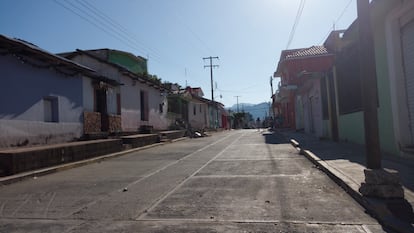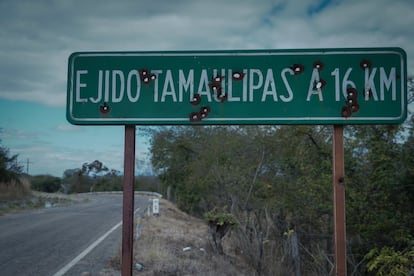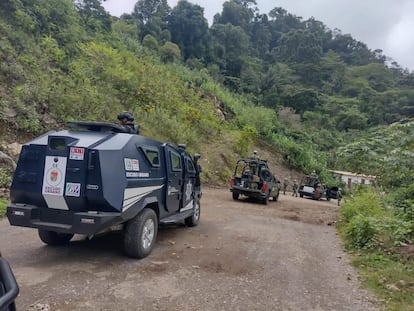Two towns held hostage by drug traffickers on the southern border of Mexico: checkpoints, murders and control over phone service and food
When consulted by EL PAÍS, activists, members of the Federal Police and local journalists confirm that it’s impossible to enter or leave Frontera Comalapa or Chicomuselo

When consulted by EL PAÍS, activists, members of the Federal Police and local journalists confirm that it’s impossible to enter or leave Frontera Comalapa or Chicomuselo, two municipalities in the state of Chiapas. They also point out that moving around has become extremely difficult in recent months, as violence and clashes in both municipalities have worsened. Last Monday, a confrontation in the area between the Sinaloa Cartel and the Jalisco New Generation Cartel (CJNG) left 11 people dead.

“At least since 2021, the residents of these towns [have been kept] as hostages. The people we’ve been able to speak with tell us that these criminal structures control their electricity, telecommunications and even their food, because by having key access roads closed, businesses are running out of supplies,” explains Dora Roblero, director of the Fray Bartolomé de las Casas Human Rights Center, known in the region as Frayba. “The Aurrera supermarket in Frontera Comalapa closed because it could no longer get access to food. Therefore, the population has to look for another place to find groceries. [This search for food] has to be done when the roads are open… and this only happens when the criminal groups decide to do so,” she adds.
Both activists and some local press reports cite residents of these municipalities, who assure them that drug-trafficking organizations have signal blockers, which are used to prevent people from using their cellphones or the internet. This increases anxiety for both those who are inside the towns, as well as for their relatives who have managed to escape.

The violence in both towns isn’t exclusive to this region. At least since 2019, the two most powerful cartels in Mexico — the Sinaloa Cartel and the CJNG — have disputed the border state of Chiapas. According to information provided by the Ministry of Defense (SEDENA), the Sinaloa Cartel controlled the state for the last decade, but recently, the incursion of its opponent has caused clashes in which hundreds of innocent people have already died.
The state of Chiapas is logistically important for organized crime in Mexico. At least nine drug-trafficking routes — five by land, two by air and two by sea — pass through it, according to data from SEDENA. Several routes used by migrants traveling to the United States from Central America also pass through here. The cartels see these vulnerable individuals as commodities.
Regarding the events that occurred in Chicomuselo on May 13, the Attorney General’s Office of Chiapas released a statement, explaining that the authorities removed the bodies after “carrying out a medical examination of them and going through the procedure of identifying the bodies with the help of their next of kin.” The document also added that “to guarantee peace in the area, investigations are being carried out. As a result of this, [there will be] patrols in the region, with the purpose of establishing [order].”
So far, it’s unknown if there’s been a rapid intervention by the army and the Federal Police. However, this strategy, which has been repeated on previous occasions in the area, hasn’t produced results. “The authorities come and go… there’s no real interest in the people,” says Roblero from Frayba.

Meanwhile, the residents of both municipalities remain under the total control of organized crime. According to 2020 figures from the National Institute of Statistics and Geography (INEGI), there were just over 80,000 inhabitants in the municipality of Frontera Comalapa and about 36,785 in Chicomuselo. However, activists warn that some 6,000 residents have fled from these two towns in the last two years. This scenario of violence also affects other municipalities in the border region, such as Motozintla and Ocosingo, where another 3,000 inhabitants have also fled, according to calculations by activists working in the region.
Human rights defenders who work in the southern region of Chiapas tell EL PAÍS that, if the situation in the state were to be compared to a hospital in crisis, Chicomuselo and Comalapa would be the emergency rooms. “There are thousands and thousands of people displaced by the dispute between the cartels. Even if the government doesn’t want to accept it, we’ve documented and estimated that, in the last two years alone, there have been about 9,000 displaced people,” says Luis Abarca, from the Digna Ochoa Human Rights Committee. The NGO is named after a nun and human rights attorney who was killed in 2001 because of her work.
For its part, the Mexican government doesn’t acknowledge the crisis in Chiapas, nor the number of displaced people reported by the organizations. President Andrés Manuel López Obrador has denied the figures and has said that only “a few” have been displaced. However, the secretary of civil protection in Chiapas, Luis Manuel García Moreno, has accepted that at least 3,780 people have been displaced in Chicomuselo alone.
According to Abarca, the cause of the crisis in Chicomuselo is that, in the municipality, there’s mining activity that’s controlled and defended by the CJNG, while the Sinaloa Cartel wants to take control of the territory. “This is something that’s already public knowledge,” he shrugs.
Both human rights activists agree that the situation in these two municipalities is ignored by the state. They predict that this neglect will continue. “We’re in an election cycle. [The politicians’] interests are different. Right now, what they’re least interested in is knowing what the population is experiencing,” Roblero concludes.
Translated by Avik Jain Chatlani
Sign up for our weekly newsletter to get more English-language news coverage from EL PAÍS USA Edition
Tu suscripción se está usando en otro dispositivo
¿Quieres añadir otro usuario a tu suscripción?
Si continúas leyendo en este dispositivo, no se podrá leer en el otro.
FlechaTu suscripción se está usando en otro dispositivo y solo puedes acceder a EL PAÍS desde un dispositivo a la vez.
Si quieres compartir tu cuenta, cambia tu suscripción a la modalidad Premium, así podrás añadir otro usuario. Cada uno accederá con su propia cuenta de email, lo que os permitirá personalizar vuestra experiencia en EL PAÍS.
¿Tienes una suscripción de empresa? Accede aquí para contratar más cuentas.
En el caso de no saber quién está usando tu cuenta, te recomendamos cambiar tu contraseña aquí.
Si decides continuar compartiendo tu cuenta, este mensaje se mostrará en tu dispositivo y en el de la otra persona que está usando tu cuenta de forma indefinida, afectando a tu experiencia de lectura. Puedes consultar aquí los términos y condiciones de la suscripción digital.
More information
Chiapas, captive territory
Archived In
Últimas noticias
Most viewed
- Sinaloa Cartel war is taking its toll on Los Chapitos
- Oona Chaplin: ‘I told James Cameron that I was living in a treehouse and starting a permaculture project with a friend’
- Reinhard Genzel, Nobel laureate in physics: ‘One-minute videos will never give you the truth’
- Why the price of coffee has skyrocketed: from Brazilian plantations to specialty coffee houses
- Silver prices are going crazy: This is what’s fueling the rally









































